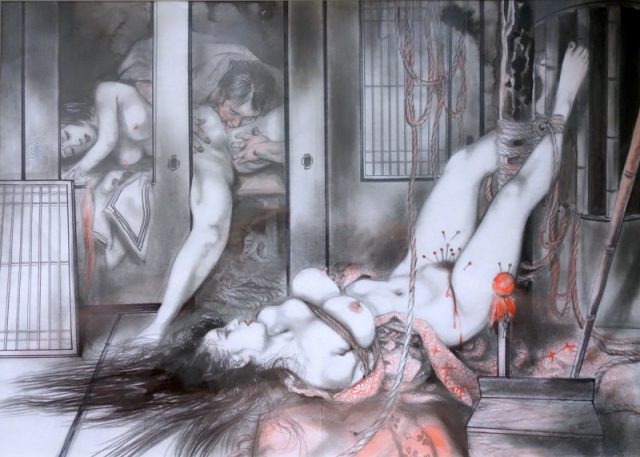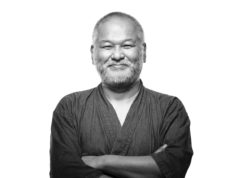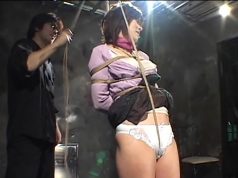I first met Nuit de Tokyo at a rope-play event in Japan at a time when my Japanese language skills were at best, rudimentary. He was kind enough to sit with me and guide me through the performances, introducing me to individuals such as his fellow ex-pat Bakushi friend, Aku Aku san, and top names like Akira Naka san and Hajime Kinoko san amongst others, and for this I thank him as a true French gentleman, and recognize somebody who enjoys helping others to understand. As a gaijin having been involved in the Japanese Kinbaku scene longer than most, and with an excellent command of the language and culture, he is known in the wider community for providing sound, informative insights in an uncontroversial and diplomatic manner.
For this interview Nuit de Tokyo has kindly permitted us to publish images from his private collection: 1. SM illustration, Juan Maeda (Kotobuki-yasu), 2. SM painting, Kato Kahoru, 3. SM painting, Shoji Oki (Wataruni).
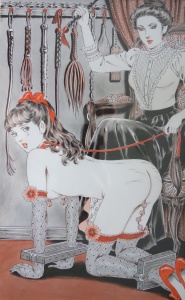 Sin: Nuit de Tokyo, did your passion for Kinbaku start when you first started coming to Japan, or does it date back further?
Sin: Nuit de Tokyo, did your passion for Kinbaku start when you first started coming to Japan, or does it date back further?
Nuit de Tokyo: I started reading [the work of the Marquis de] Sade in my first year of high school in the early seventies. It was in the home library in the leather bound first public edition by the French publisher Jean Jacques Pauvert, who had famously to fight censorship and obscenity laws at the time of publication. Being from a slightly pre-internet generation, I only became aware of Japanese SM on one of my first trips to the country initially for vanilla reasons, stumbling by chance on Kinbaku books in 1992 while looking for Mangas (Japanese Comics) in a Tokyo bookshop. Kinbaku is the art of tight binding in its Japanese tradition. There are other terms, including ‘Shibari’, but we will use Kinbaku in the present interview so as not to confuse the reader. This was the real start of my interest in Japanese rope and SM, in its photo book and magazine form, in novels, and at the time, VHS video format, and ultimately in its live incarnation. From that time I started a collection of magazines, books and photo-books which now includes complete sets of Kitan Club, Uramado, SM Mania, SM Sniper, SM Frontier, SM King, SM Kitan, Pocket SM, Specially SM, SM Bizarre and partial collections of most other Japanese SM magazines, in addition to most of Sugiura Norio’s photo books, I believe all of Akechi Denki’s photo books and videos, and finally, most or maybe all SM novels published in Japan in the last 70 years.
Sin: How did you make the transition from reading to actually tying?
Nuit de Tokyo: I was tying based on the photos I was seeing. But, using photo books or videos is not as good as learning directly from a Sensei, firstly because there are things that cannot be transmitted by video (rope tension is one, but there are others) and secondly, because only a Sensei will be able to tell you when you suck. So serious practice of high-level rope only started when I came back to Japan for an extended stay around 2003. At that time, I had enough knowledge of the Japanese language to interact with the local scene.
Sin: Did you pick up Kinbaku from watching and absorbing other Bakushi, or did you opt for formal training?
Nuit de Tokyo: Osada Steve Sensei was my first real teacher, and Asahi Ageha briefly my first real practice model. It was a time when Osada Ryū was still not yet properly formalized, Osada Ryū Gote and Teppo were still in a state of flux, and the Futomomo not yet heard of. Osada Steve introduced me to Nawashi Kanna Sensei before his retirement in 2005 (I still remember a lesson on Teppo with Kanna at the time), and to Yukimura Haruki Sensei shortly thereafter. I believe we were the first male students of Yukimura san, as he was only teaching mistresses at the time. Apart from Osada Steve, my two Senpai in the Yukimura Style are Himuro Eve and Murasaki (from top class mistress club La Siora), both hardcore mistresses. At this stage it is worth noting that even if the public representation in films or photos of Kinbaku is often guy on girl, the practice is, as Asahi Ageha pointed out in an interview a long time ago, probably 80% girl on guy, at least in Japan as SM clubs there have far more demand for female tops than for female bottoms. When Nawashi Kanna came back to the scene in 2010, Osada Steve and I were the first to take a lesson from him, and eventually I completed the full course of Nawashi Kanna Rope Study Group. Although I’m not a Deshi in the Japanese sense, I belong to a group of three rather regular students of Nawashi Kanna in Tokyo. This being said, I probably grew closer to Yukimura Haruki over the years and I am now a fully certified instructor in Yukimura Ryū (Style), and I was an assistant to the Sensei during his workshops in Copenhagen and Los Angeles a couple of years ago. Although I am now based outside of Japan, I still meet him at least once a month in Tokyo. I have performed at various events in Tokyo, Osaka, Sydney, and Hong Kong, including Ō-nawa Asobi, invited by Yoi Yoshida and Shigonawabingo from Bar -UBU-, and one event in Tokyo last year invited by Hajime Kinoko and Kazami Ranki. But, I am strictly an amateur, and I probably have as much, possibly more interest in the fantasy world around SM, including novels, films, illustrations but also Kotobazeme word torture (the verbal communication while doing rope; probably a lesser known aspect of Japanese SM), than I have in rope knot technique. To borrow some words from a video by Nureki Chimuo, I have as much interest in the ‘Kokoro’ (the heart) as much as the ‘Katachi’ (the form). The distinction will be familiar to students of Sino-Japanese martial arts, in the form of the dialectical relationship between internal and external style.
Sin: Would you advise learning at least some Japanese in order to better understand Kinbaku, and what common misconceptions do you come across?
Nuit de Tokyo: Eroticism, and SM as part of it is, as are many human activities, in part universal, and in part anchored within a localized social framework. Flagellation novels in Victorian England are not identical to post-war spanking literature on the U.S. West Coast. As such, Kinbaku is a practice happening in a segment of Japanese society among individuals sharing some sort of common education and language. So being familiar with the setting will help in a certain way. For instance, going beyond language, many (and historically all) Japanese sleep on the floor on tatami (thick straw mats) covered by a Futon (thin cotton mattress). They also make love on these tatami. Not surprisingly, a lot of what people call in the West ‘floor work’ is based on the fact that sex is going to happen after rope-play (at the very least in imagination), and on the same tatami. If you have not tried it, having sex on a tatami is very different from having sex in bed. There’s firmness to the tatami that requires changes in body positions compared to soft bed techniques. I believe it is very hard to understand the deep rationale behind Yukimura Sensei floor work if you do not have a significant experience of making love on a tatami. And in a sense, if you spend enough time in Japan to have a significant experience of tatami love making, it is very likely you will learn some Japanese words, including hopefully “Kimochi”, with the general sense of feelings, but here meaning ‘it feels good’.
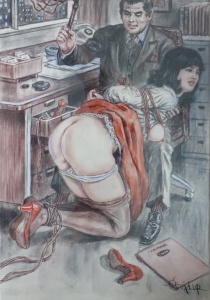 Sin: As a gaijin in a unique position in the Japanese scene, could you comment on how they see our interest in their SM culture?
Sin: As a gaijin in a unique position in the Japanese scene, could you comment on how they see our interest in their SM culture?
Nuit de Tokyo: It is probably difficult for me to really comment on how the Japanese see something, but I am sure that any foreign interest in Japanese Kinbaku is generally seen as positive, and the Japanese rope artists are extremely happy and grateful to be given the opportunity to show their art outside of Japan. Teaching rope to foreigners is a somewhat more complicated subject, as standard Japanese teaching methods do not necessarily carry very well outside of Japan, although they are more readily understood by people with some experience of training in Sino-Japanese martial arts. Naka Akira often recalls that he spent two years going to Nureki Chimuo’s rope group before being authorized to undo the masters’ ropes on the model. And studying in Japan may sometimes mean doing a Gote Shibari 40 times in one afternoon until the ‘center is in the center’. So, in general they welcome foreigners wanting to learn, but are not so sure how to respond to that demand. And to go back to an aforementioned subject, Japanese experts often have a pretty good handle on how to transmit the form (Katachi) to foreigners, but are often left scratching their heads on how to transmit the heart (Kokoro) if only because of the language difficulties, e.g. a lesson with Yukimura Haruki may involve a very long conversation, only possible if you speak Japanese. But, also because of a different approach to life sometimes Japanese experts get the impression that some foreigners are only interested in the rope handling part, and are not that interested in the Kokoro part. On this topic there is a well-known Zen story about a famous monk pointing to the moon, and some people only looking at the finger.
Sin: Would you also advocate the camaraderie and mutual respect of the Japanese Bakushi in the rapidly growing Western Kinbaku scene?
Nuit de Tokyo: I once introduced a well known Australian rope artist to Aotsuki Nagare san in Tokyo, and Aotsuki Nagare welcomed him by using one of his favorite English sentences: “We are all rope family”. It is important to remember that rope people in Japan are outcasts, and not Shakaijin (society people). They are ‘underground’ to take a favorite word of Akechi Denki (1940-2005). Historically, theater performers in Japan were ranked at the lowest possible level of society, alongside the itinerant merchants and gamblers walking from fair to fair. Nureki Chimuo (1930-2013), who belonged to a respectable Kabuki family, was ostracized by his family due to his line of business and was never invited to family reunions. Upon his death, his family did not disclose the funeral ceremony location or timing and people like Naka Akira or Sugiura Norio who have spent more than 30 years with him do not even know where his tomb is. So being cut from the rest of society, there is a de facto solidarity within the ‘rope family’ in Japan, a kind of outcast community of purpose, not unlike an African village surrounded by the jungle where survival of an individual cut from the group is marginal at best. It does not mean that there are never deep enmities, but the fractious aspect of large part of the rope scene in the West, be it in America or Europe is hard to understand from Japan. In particular, Japanese Bakushi with different styles will often invite each other to their events. And to comment once again on a recent incident, if someone does something impolite or bad, the aim is not to push them out of the family so much as to try and keep him/her in the fold – eventually asking a third party to mediate if tempers are frayed – even if he/she has to bow with the forehead hitting the ground one hundred times or to cut his/her little finger.
Sin: We once talked in Roppongi about historical rope stocks in Japan. How important would you say is the quality and feel of the rope that you use, the reasons you use this type of rope, and what is your preferred preparation technique?
Nuit de Tokyo: Even if hemp cultivation in Japan was abolished after the Second World War at the instigation of the U.S. authorities, local cultivation of jute continued into the 1990s and rope manufacturing in Japan based on locally produced fibers continued until the end of the 1990s. Unfortunately, due to price pressures from imports, most rope manufacturing in Japan disappeared progressively and the few remaining factories are using imported fibers. As a result, we are not able now to purchase rope of the quality we still had 15 years ago. Some Bakushi (people doing Kinbaku and recognized as eminent by their peers) have been able to hold to an old stock of rope but they are unlikely to share and it would be impolite to ask. This all being said, some manufacturers in Japan are still producing good rope using foreign fibers. Rope preparation itself is a complicated subject depending upon your style and your frequency of tying. Yukimura Haruki, Naka Akira and Nureki Chimuo before him, and Masato Marai are famous for not preparing rope except by prior usage (first used for suspension, then for body contact). Bakushi from the Akechi style (in the wider sense) with a larger need for dynamic rope handling usually prepare their rope. Today, the best preparer is probably Kitagawa Sensei, but Otonawa, who often goes to Kitagawa salon in Yokohama, is coming very close, Nawashi Kanna also has extremely high preparation skill in darker tones. I do not think my personal choices are very important in that matter, but I use beeswax and Jojoba. The traditional Japanese style is with Bayū (horse fat), but it is just too hard to find where I reside now. I do think that Bayū gives a better result in the end, but the real key is careful equalization of tension within the rope and rope polishing with a cloth, which will give you the real ease of use.
Sin: There is Shunga art dating back centuries depicting eroticism with rope, and at the same time it was used for penal restraint. How do you observe the way Kinbaku has been learnt historically in Japan, and do you see any difference in the ethos of tying for sexual purposes versus tying to preserve a technique of Japan’s feudal past?
Nuit de Tokyo: One of my friends is a Deshi (official student taught in one to one sessions on the fine points of the art and given a name in the Ryū from the Sensei) to a direct descendant of a samurai and has been learning for many years the art of samurai fighting. It includes more than 250 Kata (codified forms) among which more than 10 forms of Torinawa (the art of capturing criminals with rope, often also called Hojōjutsu), so there is a strong technical heritage of rope handling in Japan. It is also fair to assume that if metal had been abundant in Japan and metal restraints had been more widespread, there would be no rope binding techniques and no Kinbaku. Still, Kinbaku, as originally highlighted by Itoh Seiyu (1882-1961), is more than just rope handling. Itoh Seiyu published the first Japanese photo book of women tied in 1926, and was also the last of the Ukiyoe (woodblock prints) masters as well as an art critic and a theater director. His Ukiyoe training meant that he was familiar with Shunga, the Japanese erotic wood prints, as exemplified by Utamaro (1753-1806) but also with the work of the ‘cruelty image’ of Ukiyoe masters such as Tsukioka Yoshitoshi (1839-1892), whose work was in part based on the vernacular Chinese novels, most notably the Japanese translation of ‘Shui Hu Zhuan’ (Outlaws of the Marsh), a long novel of tattooed bandits, torture and punishments initially published in the 14th century. But, Itoh Seiyu’s work as part of the art intelligentsia of the time also meant that he had access to the first private edition translations of European and Indian sex and erotic books. He was not the sole Japanese in his situation. Mori Ogai (1862-1922) published his ‘Vita Sexualis’, one of the first Japanese erotic publishings with a western influence in 1909, and the Taishō era (1912-1926), a period of intense creativity in Japan before the rise of the Shōwa military government and the war, was marked by the emergence of the first Fuzoku (‘manners of the wind’, in effect ‘erotic’) magazines and the Eroguro (erotic and grotesque) movement. As a final influence, at the beginning of the Second World War, departing Europeans and Americans left behind them sexy French magazines (‘Le Sourire’, ‘Paris Plaisir’) and American pulp fiction magazines (‘Weird Tales’, ‘All Story Weekly’) which were to become the graphic models – or named model: the ‘All’ of All Story appears in the title of at least 10 post-war Japanese magazines, for the first erotic magazines published after the war in Japan among them Kitan Club, initially spearheaded by Minomura Kou (1920-1992), a direct student of Itoh Seiyu, was to become the reference SM magazine in Japan until 1975, having a defining influence on a young Akechi Denki while still in high school. So Torinawa is only one ingredient of Kinbaku, in addition to Shunga, Chinese lore, and Indian and Western eroticism. This melting pot gave us a practice pre-occupied essentially by Eros and fetishism (Itoh Seiyu himself was well known as a hair fetishist) and as such, probably more universal and also deeper than simple Torinawa applied to naked bodies. Discussing this subject with informed Japanese, they will in general indicate that people in the West are often drawing too much from the Torinawa heritage in Kinbaku, in other words saying that we are concentrating too much on the apparent external style, to the detriment of looking at what really happens. This being said, Itoh Seiyu and Akechi Denki were both known for their deep knowledge of Torinawa. Akechi Denki had accumulated an important documentation that was unfortunately destroyed upon his death. Among living Bakushi, Nawashi Kanna, Miura Takumi, Yagami Ren and many others have researched Torinawa from a technical point of view, and drawn on it as an inspiration for some of their ties.
Sin: Are there significant differences in Western and Japanese SM, and what would you say these are, and the reasons why?
Nuit de Tokyo: I wish I could answer this question, but simply defining western or Japanese SM would probably occupy us for several days and many pages, not to mention the fact that Sade’s SM and today’s SM are probably already at some distance. Very briefly, and if I were to severely limit the scope of the answer, I would notice that shame is probably more important in Japan as a vector of eroticism than guilt, while pain is probably less eroticized in Japan than in western SM. One could theorize that eroticization of shame is easier than eroticization of guilt, and that guilt requires some sort of pain space to operate. But nevertheless, Japanese and western SM share a common transgression factor, and transgression of society values, including transcendental values: I am doing something which should not be done, or which my mother told me not to do, irrespective of whether someone is watching or not, in the case of western SM. Transgression of society rules: I am doing something which is against the rules and I am being seen, in the case of Japanese SM. As a correlate, Japanese SM often requires a third party – the viewer, often depicted in Shunga images, watching sex from behind a hole in the shoji (paper window), while Western SM is often more a one to one story. It is a bit complicated to explain, but very successful Bakushi, e.g. Yukimura Haruki, Naka Akira, actually play the part of the person tying and the part of the person watching at the same time, like a Kabuki actor changing mask and persona instantly. This transgression aspect is intimately related to festive activities – ‘la fête’ in French, to carnivals, masked balls, village dances and even theater; all these experiences providing transgressive time/space situations, in practice transcending temporarily the feeling of daily life. This discussion could take us very far away from this interview’s purpose, but it is nice to note that ‘getting away from daily life’ is a common theme of Japanese personal ads in a SM context. As a result, Japanese SM is often accompanied by an intense verbalization during play. Whether the top is describing the situation to the bottom, “…now your legs are wide open and your sex is very wet” Yukimura Haruki will say, implying that someone is watching. The ‘situation’ is creating its own eroticism by resonating with the complex of rules engrained by education within the sub’s brain space. I cannot help but notice how difficult this seems to be for some western visitors to Japan to say something like that during rope. Often Yukimura Sensei will ask them to talk dirty during a lesson with a model with little effect. Now, if the top cannot enter into the fantasy world of the bottom with success, it is something that I described in another instance as a ‘heart not tied’. Or in harsher terms, if the top is ashamed of talking dirty, maybe he should try bottoming. Conversely, many westerners come as a couple to rope, in which case both the dynamic of the top having to find its way into an unfamiliar sub fantasy world, as well as the possibility of the third part viewer are lost and very little transgression happens. What is often left, but not always, and depending upon the quality of the bottom, is an empty (rope) pattern.
Sin: Are there good Japanese Bakushi still unknown outside of Japan?
Nuit de Tokyo: For historical reasons, the depth of Japanese rope is impressive, but most technical masters are now well known in the west. Among people who should be known better in the west, Miura Takumi Sensei is an important Bakushi with a very strong and personal rope, with a direct influence from Akechi Denki and a deep knowledge of Torinawa. He runs a rope dojo and a rope salon in Tokyo. The rope dojo is not accessible to casual visitors, but a visit to the salon is highly recommended to in-town visitors. But, in my mind, anyone into SM, even beyond rope, should pay a visit to Aotsuki Nagare, the owner of clubs Arcadia and Majestic in Tokyo and Osaka, a very good rope artist and a merciless whipper, but more than anything else probably the strongest top in Japan with an absolute mastery of Kotobazeme, the torture with words. When he runs his monthly salon in Tokyo, more than 20 subs regularly pay the salon fee and line up to be tied and humiliated. And his following is even larger in Osaka. His first line often is “Unveil to me your open heart”. Watch and take a lesson in ‘tying the heart’, and just be careful he does not steal your current sub.
Sin: Do you believe that the natural internationalization, the greater number of gaijin in Japan, and more traveling by Japanese has infused and blended with Japanese culture, and what would you say has been the result in the field of Kinbaku?
Nuit de Tokyo: When Japanese rope crossed the sea and went out of Japan, it did encounter non-Japanese bodies and non-Japanese minds. From a visual point of view, Kinbaku has evolved in its suspension show performance tradition – the external style, as applied to an average Japanese female shape (typically 160cm, 50kg), the translation to other body types has not been easy and is still an ongoing process, if only because different mechanical constraints (simply said, more rope) also impose aesthetic changes. So we have a little bit of the ‘western woman in Kimono’ syndrome. This being said, if we look at the really successful western Kinbaku show models, we are seeing bodies which are not very far from the Japanese averages, which are also not far from body types we see in acrobatics related disciplines (be it gymnastics, circus acrobatics or figure skating), so it is very possible that we have a ‘basketball type’ of situation where not every-body can seriously put on a successful public show. But, the external ‘show performance entertainment’ is not the most important part of the art, even if it is the part that has more readily translated to the West. Yukimura Haruki often says that ‘he is trying to bring out the hidden Eros’ of the model, so we also have to look at how Kinbaku has encountered western Eros, or the erotic domain of the Western mind. Japan has a strong animist/polytheist substrate with limited taboos about nudity. Onsen (hot thermal water public baths) are ubiquitous, many in the open air, a few of them mixed. Japan also has limited taboo about sex (an extra-marital affair is never an issue in itself for a public figure) and the Tokugawa government in the Edo period was famous for offering Shunga erotic woodblock prints as part of its auspicious gifts to visiting foreign officials, including Commander Perry who was responsible for the initial opening of Japan in the 1850s. By contrast western societies, for a large part, carry a strong monotheist apparatus of middle eastern origin where suppression of Eros, generally characterized as the original Adam’s sin, is a central point of the doctrine exemplified by the Catholic nuns and Muslim women hiding their bodies and the general commandment that ‘everyone who minimizes their sexual conduct is praiseworthy’. Which is why Shunga is in practice never shown to the public by museums in America, even though The Museum of Fine Arts in Boston has inherited historically one of the largest collections. So unsurprisingly, Kinbaku in the West has been subject to pressure to expurgate its sexual element, and has been pushed towards some sort of ‘ersatz sexless Kinbaku’ or ‘circus rope acrobatics’ or ‘yoga suspension’ with the commandment that ‘Eros must stay in the bedroom’. In a very similar vein of Eros suppression, because public depictions of rope, in contrast to its effective predominant practice of dominant female and submissive males (see supra), is mainly of women tied-up. Kinbaku has also been subject to attacks from the not very informed politically correct censorship brigade – recently denounced by Anne Rice and Jonathan Franzen – and photo shows by genius photographer Araki have ran into trouble in Berlin and Los Angeles for, as one commentator put it ‘crude exploitation and general degradation of women’. As a result, many international rope practitioners are probably closer to a not very good version of Cirque Du Soleil or to decorative body rope than to Kinbaku. Still, as Naka Akira always tells us, freedom is fundamental in our world, and if people want to get knotty and are into rope macramé, that is all good, they just have to be careful when they open a door with Kinbaku written on it, they might see sex and get more that what they bargained for, especially the models. As explained to me by a very young and sympathetic rope enthusiast I recently took around some places in Tokyo, “In a week I have had more sex and rope adventures than in all my life. I had no clue this is what Kinbaku is about.” To be honest, him being very young, his ‘in all my life’ was not that long. But, even in Japan, Kinbaku has been under attack from censorship. Kitan Club had to suspend publication several times; some Bakushi running bars, and Araki himself have been arrested and, on the technical front, Japanese magazines and internet meeting forums are full of photos of extremely bad rope by disastrous neophytes, and this has never prevented Kinbaku from striving. Kinbaku is a practice of an enlightened minority, as Akechi Denki often said, something that should remain ‘underground’. Sade himself was writing for an underground minority “I am writing for those who can understand me, and they will be able to read my works without danger.” So if Kinbaku goes from being a Japanese underground to being a world underground without ever going overground, it is still an absolutely fantastic adventure, a party of the grandest scale, and a manifest of liberty.

